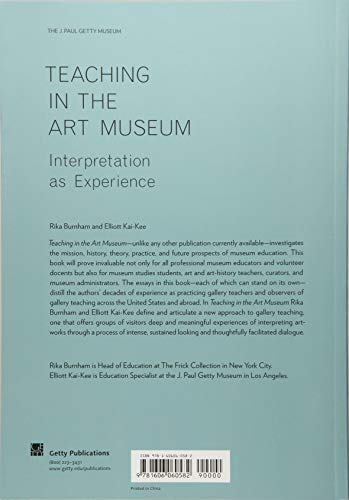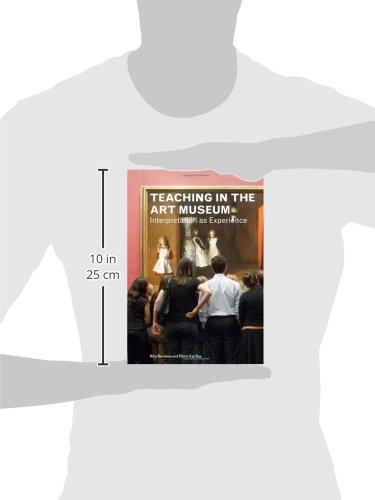



Teaching in the Art Museum: Interpretation as Experience
L**S
A sophisticated and concisely written museum education book
Art museum education has existed as a professional practice for a century in the U.S. yet, in the words of authors Burnham and Kai-Kee (2011), "in spite of some hundred years of teaching in art museums, we are still in search of a central curriculum to prepare aspiring educators and docents for gallery teaching" (p.4). The authors propose Teaching in the Art Museum as a text summarizing the history of art museum education in the U.S. and as a guide to the curriculum and pedagogy of art museum education contextualized within learning theory and philosophy. Authors Burnham and Kai-Kee describe their model of art museum curriculum as learner-centered guided interpretation that is dialogue dependent and deeply rooted in the gallery teacher as experience facilitator rather than didactic information deliverer. Within this model, the curriculum is constituted through the dialogue created between visitors and teacher within the gallery with the teacher supplementing historical or contextual information with discretion. This model positions teacher and visitors as co-learners throughout the tour. With sound theoretical foundation underpinning the work, Teaching in the Art Museum is a book suitable for a variety of audiences. Museum educators, docents and other museum education workers are clearly the primary audience. Graduate students in art education, art history, and nonprofit education and management programs can also benefit greatly from this book with its cogent summary of the history of museum education in the U.S. and clearly defined curriculum and pedagogy. The authors also write in an accessible tone that welcomes an audience of both museum education specialists and museum professionals working outside education wishing to peer into the work of their colleagues in order to gain greater understanding of the purpose and methods of contemporary museum education.
S**E
Good information
As an emerging museum education professional, I find the essays in the book quite useful. Yes, they are written in academic language, however, it's no different than any reading that one would do in upper division courses in a BFA program or in an MA program. Contrasting various approaches and having transcripts of the use of each of the approaches was probably the best thing that the authors could have done. It's made me think about what changes I need to bring about for our next intake of docents. It is heavy on theory, but I like reading and trying to understand which pedagogical approach would work best for our institution. Would I find this useful if I were merely a docent? Maybe. This is making me think more about planning and teaching our volunteer educators.
B**S
Recommended for Art Museum volunteers and Docents
In a series of essays, the authors cover issues of education and visitor experience in the world of art museums. Educational strategies and controversies, views of volunteer vs. professional educators, and specific techniques for engaging the museum visitor are discussed, with many anecdotes and examples. A must-read for art museum educators and administrators.
M**K
Valuable and insightful
Very informative and eye opens techniques in helping people understand how to view works of art. A valuable piece of writing for any teacher, docent or instructor in the arts field.
T**R
Not Practical for Docents
This book is based on the author's own philosophy about teaching in an art museum. She spends an hour or more with a group of students, exploring a single work of art. She wants students to come up with their own reactions, opinions and views.The author recounts sessions that she has had with students at the Metropolitan Museum of Art and other museums. For example, one chapter is devoted to an hour session at the Met discussing a French tapestry. The students are seated on stools around the work, and the author describes their discussion.The author does not address how this approach would work with docents on public museum tours. Docents, who are usually volunteers, must guide visitors though the museum in a set period of time. Members of the public would be surprised to cover only one work on a docent tour (unless they knew in advance that the tour covered one work only). The author has little practical advice about how volunteer docents in museums should give public tours. She believes in having a dialogue with the visitors, but she doesn't believe that docents should ask questions. (Chapter 6). She seems to question whether volunteer docents should even play a role in the "museum of the future." From the last paragraph of the book:"But in the museum of the future, educators move from the periphery to the center. Responsible for the continuing translations of meaning that occur in the new museum, the educators who teach are the most accomplished members of the education department, best qualified to shape and animate museum programs. They lead the department, define its philosophy and mission, and overturn the historical definition of teaching as a peripheral, volunteer, or entry-level activity." Page 152.If you would like to read about this author's own experiences with art education, the book might interest you. It will not be helpful to docents who are looking for concrete and practical guidance in giving tours to the public.
S**S
Four Stars
A required read as part of my museum docent training
J**B
Excellent
Presently taking a docent class and this book very accurately and in depth describes the history of docents and how to present and interact with your groups.
H**F
Five Stars
In perfect condition. Important for every art lover, museum lecturer, and person interested in communication.
M**.
Easy read. not too wordy
This was very useful for a chapter that I was writing. It looks more like a journal. It's split into chapters but all written by the same authors so it has a very nice flow through out
L**U
a very good book for anyone working as a guide or docent ...
a very good book for anyone working as a guide or docent in a museum. Practical tips and lessons on how to approach an audience and how to make them participate so that they can get the maximum pleasure and understanding of their museum visit. Highly recommended to all.
A**R
A great book to consult
Well writen. A great book to consult.
Trustpilot
5 days ago
2 weeks ago